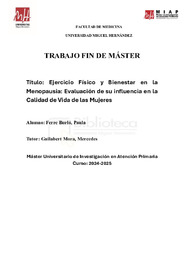Please use this identifier to cite or link to this item:
https://hdl.handle.net/11000/36874Ejercicio Físico y Bienestar en la Menopausia: Evaluación de su influencia en la Calidad de Vida de las Mujeres
| Title: Ejercicio Físico y Bienestar en la Menopausia: Evaluación de su influencia en la Calidad de Vida de las Mujeres |
| Authors: Ferre Burló, Paula |
| Tutor: Guilabert Mora, Mercedes |
| Editor: Universidad Miguel Hernández |
| Department: Departamentos de la UMH::Psicología de la Salud |
| Issue Date: 2025-06-03 |
| URI: https://hdl.handle.net/11000/36874 |
| Abstract: Introducción: El climaterio representa una etapa trascendental en la vida de la mujer, caracterizada por una serie de transformaciones fisiológicas y emocionales que repercuten de manera significativamente negativa en su calidad de vida. No obstante, se ha observado que la reducción de la sintomatología asociada a esta fase conlleva una mejora sustancial en dicho indicado. En este sentido, la práctica regular de ejercicio físico se perfila como una estrategia terapéutica eficaz para atenuar los efectos del climaterio, generando beneficios en los ámbitos biológico, psicológico y social, lo que, en última instancia, se traduce en una mejora integral de la calidad de vida. Objetivo: Analizar la relación entre la actividad física y la calidad de vida en mujeres en etapa climatérica, con el propósito de determinar su influencia en el bienestar físico, emocional y social. Metodología: El diseño del estudio que se propone es cuantitativo descriptivo observacional y de corte transversal. La población objeto de estudio estará conformada por 381 mujeres en etapa de climaterio adscritas a los centros de salud del área I de salud. Se recogerán diversas variables sociodemográficas y clínicas, entre ellas: edad, Índice de Masa Corporal, estado civil, número de hijos, nivel educativo, situación laboral, nivel de renta, hábitos tóxicos, tipo de alimentación, tiempo desde la menopausia, uso de terapia hormonal sustitutiva y presencia de enfermedades crónicas. Como instrumento de medida se emplearán la Escala Cervantes reducida compuesta por 16 ítems que evalúan cuatro dimensiones de calidad de vida, y el cuestionario IPAQ, que incluye 7 ítems para medir el ejercicio físico. El análisis estadístico de los datos se efectuará mediante el SPSS. Conclusión: Elpresente estudio aspira a generar evidencia relevante que permita optimizar las recomendaciones relacionadas con la práctica de ejercicio físico durante el climaterio, fomentando así el diseño e implementación de programas de actividad física que promuevan el envejecimiento saludable, disminuyan la sintomatología y potencien la calidad de vida de este grupo poblacional. Introduction: The climacteric period represents a momentous stage in women’s lives, characterized by a series of physiological and emotional transformations that have a significant negative impact on their quality of life. However, it has been observed that the reduction of the symptomatology associated with this phase leads to a substantial improvement in this indicated. In this sense, the regular practice of physical exercise is emerging as an effective therapeutic strategy to mitigate the effects of climate change, generating benefits in the biological, psychological and social areas, which ultimately is translated into a comprehensive improvement in the quality of life. Objective: Analyze the relationship between physical activity and quality of life in women in climacteric stage, with the purpose of determining their influence on physical, emotional and social well-being. Methodology: The design of the proposed study is quantitative descriptive observational and cross-sectional. The target population will be 381 climacteric women assigned to health centres in area I. Various sociodemographic and clinical variables will be collected, including: age, BMI, marital status, number of children, level of education, employment status, income level, toxic habits, type of diet, time since menopause, use of HRT and presence of chronic diseases. The reduced Cervantes Scale, composed of 16 items that evaluate four dimensions of quality of life, and the IPAQ questionnaire, which includes 7 items to measure physical exercise, will be used as a measurement instrument. The statistical analysis of the data will be carried out using SPSS. Conclusion: The present study aims to generate relevant evidence that allows the optimization of recommendations related to exercise practice during the climacteric period, Thus encouraging the design and implementation of physical activity programs that promote healthy aging, decrease symptomatology and enhance the quality of life of this population group. |
| Keywords/Subjects: climaterio menopausia calidad de vida exercise quality of life |
| Knowledge area: CDU: Ciencias aplicadas: Medicina |
| Type of document: info:eu-repo/semantics/masterThesis |
| Access rights: info:eu-repo/semantics/openAccess Attribution-NonCommercial-NoDerivatives 4.0 Internacional |
| Appears in Collections: TFM - M.U en Investigación en Atención Primaria |
.png)

